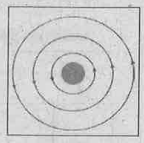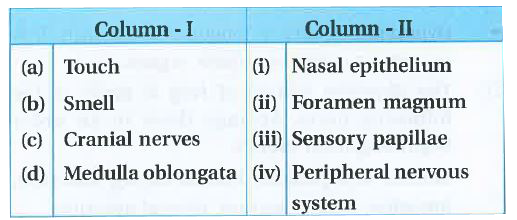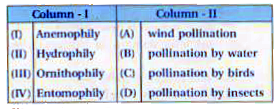క్రింది జతలో ఏది సరైన జతల సమూహం? i) అమిటర్ ( ) a) వలయంలో సమాంతరంగా కలుపబడుతుండు. ii) టాప్ కి ( ) b) వలయంలో శ్రేణిలో కలుపుతుంది. iii) వోల్టమీటర్ ( ) c) వలయం కలపడానికి, విడదీయడానికి ఉపయోగిస్తారు. పై వాటిని జతపరుచుటకు క్రింది వాటిలో సరైన సమాదానం.
i-a, ii-b,iii-c
i-b,ii-c, iii-a
i-c, ii-a,iii-b
i-a,ii-c,iii-b
Step by step video & image solution for క్రింది జతలో ఏది సరైన జతల సమూహం? i) అమిటర్ ( ) a) వలయంలో సమాంతరంగా కలుపబడుతుండు. ii) టాప్ కి ( ) b) వలయంలో శ్రేణిలో కలుపుతుంది. iii) వోల్టమీటర్ ( ) c) వలయం కలపడానికి, విడదీయడానికి ఉపయోగిస్తారు. పై వాటిని జతపరుచుటకు క్రింది వాటిలో సరైన సమాదానం. by Physics experts to help you in doubts & scoring excellent marks in Class 10 exams.
Updated on:21/07/2023Topper's Solved these Questions
Similar Questions
ఒక భూతద్దం గుండా సూర్యకిరణాలను పంపు విధముగా అమర్చిన దానిని సూర్యుని వైపు కదిలిస్తున్నా వేరొక వైపు కాంతిపుoజం సన్నగా, తీవ్రతరంగా మారును దీనికి కారణము
View Solutionపటంలో చూపిన విధంగా అయస్కాంత రేఖలుంటే తీగచుట్ట గుండా ఏ దిశలో విద్యుత్ ప్రవహిస్తుంది ?

View Solution(a) a- i ,b-iii,c-ii (b) a-iii,b-ii,c- i (c) a-ii,b-iii,c- i (d) a-ii,b- i ,c-iii
View SolutionMatch the column-
Column IColumn IIA Toxinsi. MorphineB Alkaloidsii. AbrinC Lectinsiii. VinblastinD. Drugsiv. Concanavalin A
ABCDiiiiiiiviiiiiiiviiiiviiiviiiiii
View Solution5∗10−3కి.మీ=0.005కి.మీ
View Solution(0,5) బిందువు ఈ క్రింది వానిలో దేనికి చెదును?
View SolutionMatch the items in column 'A' and column 'B' and choose correct answer.
ColumnAColumnB(i)Lady bird(A)Methanobacterium(ii)Mycorrhiza(B)Trichoderma(iii)Biological control(C)Aphids(iv)Biogas(D)Glomus
The correct answer is A. (i)-B (ii)- D (iii)-C (iv)-A B. (i)-C (ii)- D (iii)-B (iv)-A C. (i)-D (ii)-A (iii)-B (iv)-C D. (i)-C (ii)-B (iii)-A (iv)-D
View SolutionMatch the followings and choose the correct answer. (A) (a - ii), (b - iii), (c - iv), (d - i) (B) (a - iii), (b - ii), (c - iv), (d - i) (C) (a - i), (b - iii), (c - ii), (d - iv) (D) (a - ii), (b - iv), (c - iii), (d - i)
View SolutionMatch the following with reference to cockroach and choose the correct option. (A) (a - iii), (b - iv), (c - ii), (d - i) (B) (a - iv), (b - iii), (c - ii), (d - i) (C) (a - iv), (b - ii), (c - iii), (d - i) (D) (a - ii), (b - iv), (c - iii), (d - i)
View SolutionMatch the followings and choose the correct answer.

(A) (a - iii), (b - i), (c - ii), (d - iv)
(B) (a - ii), (b - i), (c - iv), (d - iii)
(C) (a - iii), (b - iv), (c - ii), (d - i)
(D) (a - iii), (b - i), (c - iv), (d - ii)
View SolutionMatch the following column .
Column -I Column-II (a) Molecular oxygen (i) α− ketoglutaric acid (b) Electron acceptor (ii) Hydrogen acceptor (c) Pyruvate dehydrogenase (iii) Cytochrome -C (d) Decarboxylation (iv) Acetyl Co-A
(A) (a-ii),(b-iii),(c-iv),(d-i)
(B) (a-iii),(b-iv),(c-ii),(d-i)
(C) (a-ii),(b-i),(c-iii),(d-iv)
(D) (a-iv),(b-iii),(c-i),(d-ii)
View SolutionMatch the two columns: (A) (I-A),(II- B), (III- D), (IV- C) (B) (I-B), (II-A), (III-D), (IV - C) (C) (I- A), (II-B), (III-C), (IV- D) (D) (I- D), (II- A), (III-C), (IV-B)
View SolutionMatch the two columns:

(A) (I-C), (II-D), (III-B), (IV-A)
(B) (I-D), (II-C), (III-A), (IV-B)
(C) (I-C), (II-B),(III-D), (IV-A)
(D) (I-B),(II-D),(III-C),(IV-A)
View SolutionMatch the two columns:

(A) (I-A), (II-B), (III-C), (IV-D)
(B) (I-B), (II-A), (III-C), (IV-D)
(C) (I-A), (II-C), (III-B), (IV-D)
(D) (I-D), (II-B), (III-C), (IV-A)
View SolutionMatch column I with column II and select the correct option from the given codes.
Column IColumn IIA) Rivet Popper hypothesis(i)Paul EhrlichB) Long-term ecosystem <br> experiments using outdoor plots(ii)David TilmanC) Species-area relationships(iii)Alexander von <br> Humboldt
(a) A-(iii), B-(i), C-(ii)
(b) A-(i), (ii), C-(iii)
(c) A-(i), B-(iii), C-(ii)
(d) A-(ii), B-(iii), C-(i)
View SolutionMatch the columns I and II , and choose the correct combination from the options given . {:("Column I","Column II (Major pigments)"),((a)"Chloropyceae","(i) Chlorophyll a,c fucoxanthin"),((b)"Phaeophyceae","(ii) Chlorophyll a,d,phycoerythrin"),((c)"Rhodopphyceae",(iii)"Chlorophyll a,b"):} (a) a-iii, b-i, c-ii (b) a-iii, b-ii, c-i (c) a-ii, b-i, c-iii (d) a-i, b-iii, c-ii
View Solution
